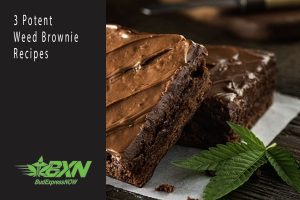If you want to get the most out of your marijuana, it needs to be decarboxylated first. Decarboxylation is a chemical reaction which removes a carboxyl group in order to cause changes in the chemical makeup. When marijuana is decarboxylated, the THCA within turns into THC- the cannabinoid which gives you the psychoactive effects of marijuana.
Decarboxylation also applies to other cannabinoids. It requires heat and time, and the reason you burn cannabis is that it needs to undergo decarboxylation it in order to activate the cannabinoids and get the best effects. Some people even decarboxylate their own weed at home to create cannabis edibles. Here’s a guide to what is decarboxylation and why is it important.
What Is Decarboxylation?
Decarboxylation is an organic process in which a carboxyl group is removed from a chemical compound. It’s a chemical reaction that can happen in all kinds of compounds, but in the case of marijuana, it’s the process which turns THCA into THC.
Marijuana contains many chemical compounds or cannabinoids. However, while it’s mostly known for its THC content, THC is only activated via decarboxylation. Before decarboxylation, freshly harvested cannabis is high in THCA. Decarboxylation is the process which transforms THCA into THC, as well as activating many other cannabinoids.
Decarboxylation is usually brought about by heating marijuana. This is why you can smoke or vape marijuana for instant THC effects. However, other methods of decarboxylation are also used to create products such as oils and edibles.
Why Is Decarboxylation Important?
Decarboxylation of marijuana is important as, without it, you won’t get the powerful effects of THC and other cannabinoids. THCA does have some medical benefits, and some people consume fresh cannabis for the effects of THCA. However, THCA is non-psychoactive and needs to be decarboxylated for users to get the psychoactive effects of THC.
Decarboxylation converts THCA into THC, the chemical in marijuana which makes you high. It also helps activate other cannabinoids such as CBD, CBN, and CBG. These are the cannabinoids which give you many of the medical effects of marijuana. As such, marijuana is much more useful and high in cannabinoids and terpenes after decarboxylation.
The process can also help with creating certain kinds of marijuana products. For instance, to create marijuana edibles, marijuana must be decarboxylated before being cooked into oil or butter. Without this process, it won’t be high in THC and won’t give users the desired effects. This is why you’ll often hear about decarboxylation when it comes to the production of marijuana products.
How Does Decarboxylation Happen?
There are many methods of decarboxylation, and while decarboxylation can happen fairly naturally over time, it’s mainly caused by high temperatures. This is why burning or heating marijuana results in high levels of THC being activated.
When you first harvest freshly grown marijuana, it’ll be high in THCA. After undergoing the drying and curing process, low levels of THC can be detected. However, it still needs to be brought to a much higher temperature before decarboxylation happens.
Smoking or vaping weed instantly causes decarboxylation, hence why these methods will cause you to get high. However, in other cases, weed needs to be heated up for a sustained amount of time in order to convert the THCA into THC. Generally, THCA decarboxylation starts at approximately 220 degrees Fahrenheit (105 °C), although it needs sustained heat. Burning or vaping marijuana is usually done at much higher temperatures for fast effects.
How to Decarboxylate Your Weed
If you simply want to get the psychoactive effects of cannabis, you don’t need to undergo any lengthy decarboxylation process. Once you have dried and cured cannabis, you can add it to a joint, bong or pipe and light it up to cause instant decarboxylation and inhale THC. The same applies to vaping- a temperature of around 210°C (410°F) is considered the optimal temperature for THC.
However, you can also decarboxylate your marijuana at home for use in edibles. This usually involves heating it for an extended amount of time before cooking it into butter or oil. You can also use decarboxylated marijuana to create other THC products.
To decarboxylate your weed at home, you’ll need an oven and some parchment paper. Spread the parchment paper over a baking sheet and grind your marijuana. Apply the marijuana over the parchment paper and put it in the oven for around 30-45 minutes at a temperature of 220°F. After the time is up, your marijuana is ready.
It’s important to not make the temperature higher. Decarboxylation of marijuana requires a moderate amount of heat for a sustained time, and going too high can cause you to lose THC. Some people also use a slow cooker to decarboxylate their weed. After decarboxylation, you can infuse your cannabis into cannabis butter, oil or other products.
Does All Cannabis Need to be Decarboxylated?
Cannabis needs to undergo decarboxylation to get the optimal effects of the cannabinoids. However, you usually do not need to worry about decarboxylating your weed yourself. While you’ll need to carry out the process to create your own edibles, most products are ready to use without decarboxylation.
Cannabis strains and concentrates require decarboxylation, but this is usually achieved via burning or vaping them for inhalation. Other products, such as marijuana edibles, tinctures, and topicals use extracts from decarboxylated cannabis. As such, you don’t need to heat any of these up to get their effects. You can simply take them to get the effects of THC.
Conclusion
Decarboxylation is a chemical process which converts the THCA in marijuana into THC, as well as bringing out the other beneficial cannabinoids contained in the plant. Most marijuana users don’t really need to concern themselves with decarboxylation as it’s a process that happens naturally when you smoke or vape weed.
Those who plan to make their own cannabis edibles will need to know how to decarboxylate their weed before they do so. Luckily, it’s an easy enough process that simply requires a certain level of heat for a sustained time. Other marijuana products use THC extracts which have come from decarboxylated weed. These don’t require extra heat to use.








